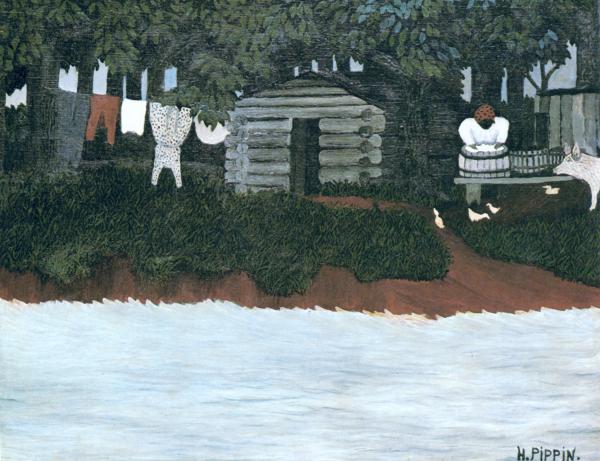Description
In 1940, Horace Pippin, an outstanding American painter of African -American origin, offers us through his work "A washing" a penetrating look at everyday life, the culture and experience of the human being, dust and water included. Pippin, who stood out for his approach related to realism, creates in this painting an atmosphere that evokes both the intimacy of the home and the arduous and daily work of the African -American people of their time. The composition is rich in details, which leads the viewer to a deeper reflection on the seemingly simple acts that underlie everyday life.
The painting presents a woman on your back, at a time of concentration and effort, while performing the task of washing clothes. This act, which might seem trivial, becomes through the Pippin brush a symbolism of life, resistance, and industriousness of women. The female figure, dressed in a simple dress, occupies the center of the composition and gives the work a strong emotional and cultural burden. This representation is not just a portrait of the routine; It is a recognition of the work of African -American women, often invisible in art history.
The use of color in "Washing" is essential for its visual impact. Pippin opts for a terrious and warm palette, where brown and ocher tones predominate. This controlled use of color not only provides a sense of warmth and closeness, but also underlines the connection of the figure with its environment. The contrast that presents between the human figure and the water, in addition to the shadows that appear in the task of washing, point to the multidimensionality of the work presented. Water, in its fluid state, is contrasted with the hardness of daily life, reflecting a subtle tension between the elusive and the everyday.
Pippin's style, influenced by his experience, both in the field of art and his personal life, is characterized by a narrative approach that does not spare in the color or wealth of visual details. Its way of articulating the complex reality of African -American life in the United States the years, it can be observed not only in "washing," but also in other works, where the scenes of everyday life are high to a representation worthy of be contemplated and valued.
Pippin, a self -taught artist, began painting at an advanced age, after returning from World War I, an experience that marked him deeply. His singular style, which mixes influences from African -American folklore and popular painting, broke with some conventions of the art of his time, allowing him to offer a deeply personal and culturally rich narrative. "Washing" aligns with its desire to tell stories, to give voice to the experiences of your community and make everyday life a subject worthy of exploration in the context of art.
In conclusion, "Washing" is not only a visual representation of a moment in time, but a celebration of work, resistance and humanity. Through its master use of color and composition, Pippin manages to create a work that resonates meaning, inviting the viewer to reflect on the importance of daily tasks and the intrinsic value of lives that are often overlooked. It is through works such as this that art becomes a powerful environment for the narration and conservation of cultural memory.
KUADROS ©, a famous paint on your wall.
Hand-made oil painting reproductions, with the quality of professional artists and the distinctive seal of KUADROS ©.
Art reproduction service with satisfaction guarantee. If you are not completely satisfied with the replica of your painting, we refund your money 100%.

